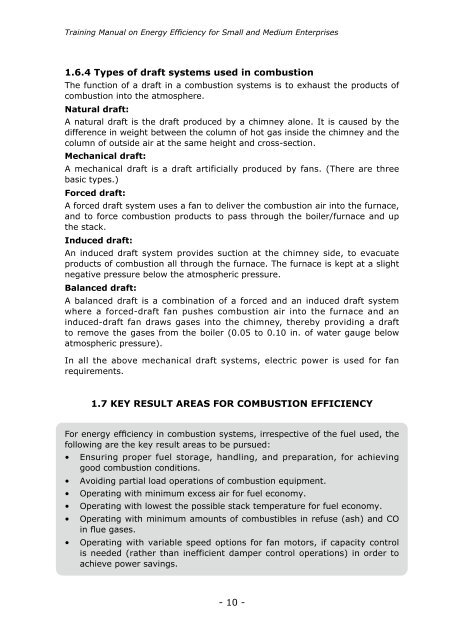Training Manual on Energy Efficiency - APO Asian Productivity ...
Training Manual on Energy Efficiency - APO Asian Productivity ...
Training Manual on Energy Efficiency - APO Asian Productivity ...
Create successful ePaper yourself
Turn your PDF publications into a flip-book with our unique Google optimized e-Paper software.
<str<strong>on</strong>g>Training</str<strong>on</strong>g> <str<strong>on</strong>g>Manual</str<strong>on</strong>g> <strong>on</strong> <strong>Energy</strong> <strong>Efficiency</strong> for Small and Medium Enterprises<br />
1.6.4 Types of draft systems used in combusti<strong>on</strong><br />
The functi<strong>on</strong> of a draft in a combusti<strong>on</strong> systems is to exhaust the products of<br />
combusti<strong>on</strong> into the atmosphere.<br />
Natural draft:<br />
A natural draft is the draft produced by a chimney al<strong>on</strong>e. It is caused by the<br />
difference in weight between the column of hot gas inside the chimney and the<br />
column of outside air at the same height and cross-secti<strong>on</strong>.<br />
Mechanical draft:<br />
A mechanical draft is a draft artificially produced by fans. (There are three<br />
basic types.)<br />
Forced draft:<br />
A forced draft system uses a fan to deliver the combusti<strong>on</strong> air into the furnace,<br />
and to force combusti<strong>on</strong> products to pass through the boiler/furnace and up<br />
the stack.<br />
Induced draft:<br />
An induced draft system provides sucti<strong>on</strong> at the chimney side, to evacuate<br />
products of combusti<strong>on</strong> all through the furnace. The furnace is kept at a slight<br />
negative pressure below the atmospheric pressure.<br />
Balanced draft:<br />
A balanced draft is a combinati<strong>on</strong> of a forced and an induced draft system<br />
where a forced-draft fan pushes combusti<strong>on</strong> air into the furnace and an<br />
induced-draft fan draws gases into the chimney, thereby providing a draft<br />
to remove the gases from the boiler (0.05 to 0.10 in. of water gauge below<br />
atmospheric pressure).<br />
In all the above mechanical draft systems, electric power is used for fan<br />
requirements.<br />
1.7 KEY RESULT AREAS FOR COMBUSTION EFFICIENCY<br />
For energy efficiency in combusti<strong>on</strong> systems, irrespective of the fuel used, the<br />
following are the key result areas to be pursued:<br />
• Ensuring proper fuel storage, handling, and preparati<strong>on</strong>, for achieving<br />
good combusti<strong>on</strong> c<strong>on</strong>diti<strong>on</strong>s.<br />
• Avoiding partial load operati<strong>on</strong>s of combusti<strong>on</strong> equipment.<br />
• Operating with minimum excess air for fuel ec<strong>on</strong>omy.<br />
• Operating with lowest the possible stack temperature for fuel ec<strong>on</strong>omy.<br />
• Operating with minimum amounts of combustibles in refuse (ash) and CO<br />
in flue gases.<br />
• Operating with variable speed opti<strong>on</strong>s for fan motors, if capacity c<strong>on</strong>trol<br />
is needed (rather than inefficient damper c<strong>on</strong>trol operati<strong>on</strong>s) in order to<br />
achieve power savings.<br />
- 10 -
















